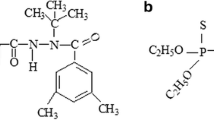Abstract
Residue dynamics of thiacloprid in cabbage and soil was studied in this paper utilizing liquid chromatography with tandem mass spectrometry (LC–MS/MS). The field trial was conducted in two sites: Beijing, China and Hubei, China. Thiacloprid dissipated rapidly with the half-life 1.3–1.6 days in cabbage and 2.1–3.1 days in soil. In the terminal residue experiment, no higher residue than 0.06 mg/kg in cabbage and 0.16 mg/kg in soil was detected, which was far below either EU MRL (0.2 mg/kg) or Japan MRL (1 mg/kg).


Similar content being viewed by others
References
Dubey JK, Patyal SK, Sharma ID, Thakur M, Kumar A (2008) Residues of thiacloprid in/on apple and tea. Pestic Res J 20:269–272
Elbert A, Buchholz A, Ebbinghaus-Kintscher U, Erdelen C, Nauen R, Schnorbach HJ (2001) The biological profile of thiacloprid - a new chloronicotinyl insecticide. Pflanzenschutz-Nachr. Bayer (Engl. Ed.) 54:185–208
Europe Commission (2010a) EU pesticides database. http://ec.europa.eu/sanco_pesticides/public/index.cfm. Accessed 29 Dec 2010
Jeschke P, Moriya K, Lantzsch R, Seifert H, Lindner W, Jelich K, Gohrt A, Beck ME, Etzel W (2001) Thiacloprid (Bay YRC 2894): a new member of the chloronicotinyl insecticide (CNI) family. Pflanzenschutz-Nachr Bayer (Engl Ed) 54:147–160
Krohn J (2001) Behaviour of thiacloprid in the environment. Pflanzenschutz-Nachr Bayer (Engl Ed) 54:281–290
Liu S, Zheng Z, Wei F, Ren Y, Gui W, Wu H, Zhu G (2010) Simultaneous determination of 7 neonicotinoid pesticide residues in food by ultraperformance liquid chromatography tandem mass spectrometry. J Agric Food Chem 58:3271–3278
Omirou M, Vryzas Z, Papadopoulou-Mourkidou E, Economou A (2009) Dissipation rates of iprodione and thiacloprid during tomato production in greenhouse. Food Chem 116:499–504
Saimandir J, Gopal M, Walia S (2009) Risk assessment of thiacloprid and its chemical decontamination on eggplant, Solanum melongena L. Pest Manage Sci 65:210–215
The Japan Food Chemical Research Foundation (2010b) The Japanese positive list system for agricultural chemical residues in foods. http://www.ffcr.or.jp/zaidan/FFCRHOME.nsf/pages/MRLs-p. Accessed 29 Dec 2010
Tomlin CDS (2006) The pesticide manual: a world compendium. British crop protection council. Alton, Hampshire, UK
Yu Y, Wu J, Stahler M, Pestemer W (2007) Residual dynamics of thiacloprid in medical herbs marjoram, thyme, and camomile in soil. J Environ Sci (Beijing, China) 19:205–209
Author information
Authors and Affiliations
Corresponding author
Rights and permissions
About this article
Cite this article
Wang, C., Guan, Wb. & Zhang, Hy. Dissipation and Residue of Thiacloprid in Cabbage and Soil. Bull Environ Contam Toxicol 87, 440–443 (2011). https://doi.org/10.1007/s00128-011-0326-8
Received:
Accepted:
Published:
Issue Date:
DOI: https://doi.org/10.1007/s00128-011-0326-8




